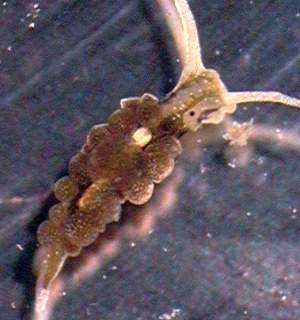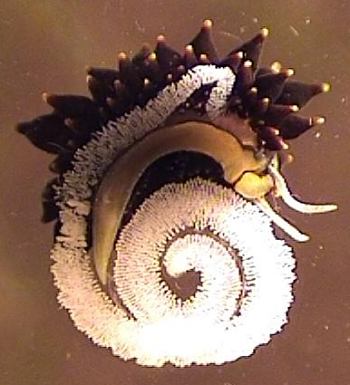

Ercolania viridis
(A. Costa, 1866)
Order: SACOGLOSSA
Superfamily: LIMAPONTIOIDEA
Family: Limapontiidae
DISTRIBUTION
Mediterrean, Alantic coast of Europe and Nth America, Caribbean.
PHOTO
Upper Photo: Lac de Tunis [southern section], Tunisia. Depth: 0 to 1m, January - March, 2003. 3-4mm long. Photo: Anis
Lower photo: Ukraine, Black Sea coast. Photo: Alexander Kurakin
Ercolania viridis is very variable in colour and consequently has a very confused nomenclatural history which has been compounded by the fact that species in two very similar looking genera, Stiliger and Placida, also have species named 'viridis' living in the same geographic region. [See discussion below.]
It ranges in colour from almost transparent, with the green of the digestive gland ducts, and the brownish colour of the viscera showing through, to animals which are heavily pigmented with black. Intermediate animals often have red speckling or dusting on the ceratal wall. The black form was named E. funerea by Costa (1867). Ercolania funerea has usually been a considered a synonym of Ercolania viridis but the name has often been used in preference to Ercolania viridis because of the possible confusion with Placida viridis and Stiliger viridis.
Vayssiere (1888) describes specimens from Marseilles in some detail. In colour he describes the body as being translucent with a blackish green or violet green tinge. There is an opaque white mark on the head and another from the pericardial hump back down the median line between the cerata. The cerata have a blackish green tinge but the green branching of the digestive gland is clearly visible. There is often a reddish tip to the cerata. In some animals a blackish tinge to the skin dominates the colour of the animal. Marcus & Marcus (1970) describe animals from Puerto Rico, in the Caribbean, as being 'blackish with clear rhinophores, tail, and pericardial area; cerata black with reddish brown tips; a patch of reddish brown on the head'.
Note: See Ercolania cf viridis for similar animal with quite different egg mass.
-
Costa, A. (1866) Saggio sui molluschi eolididei del Golfo di Napoli. Annuario del Museo Zoologico della Universita di Napoli, 3(2): 59-80.
-
Costa, A. (1867) Saggio sui molluschi eolididei del Golfo di Napoli. Annuario del Museo Zoologico della Universita di Napoli, 4(2): 26-37, pls. 1-2.
-
García Gómez, J.C. (2002) Paradigmas de una Fauna Insolita: Los Moluscos Opistobranquios del Estrecho de Gibraltar Instituto de Estudios Campogibraltarenos. Serie Ciencias 20. 397 pp.
-
Marcus, Er. & Marcus, Ev. (1970) Opisthobranchs from Curacao and faunistically related regions. Uitqaven van der Natuurwetenschappelijke Studiekring voor Suriname en de Nederlandse Antillen, 59: 1-129.
-
Marin, A. & Ros, J.D. (1988) The Sacoglossa (Mollusca, Opisthobranchia) of the South East Iberian peninsula. A Catalogue of species and presence of algal chloroplasts in them. Iberus, 8(1): 25-49. [In Spanish]
-
Ortea, J.A. & Urgorri, V. (1981) Opisthobranquios nuevos para el litoral iberico colectados en Galicia. I. Boletin del Instituto Espanol de Oceanografia, 6(288): 49-60.
-
Pruvot-Fol, A. (1954): Mollusques Opisthobranches Faune de France, 58: 1-460, Pl.1.
-
Vayssiere, A. J. B. M. 1888. Recherches zoologiques et anatomiques sur les mollusques Opisthobranches du Golfe de Marseille. Deuximem Partie, Nudibranches (Cirrobranches) et Ascoglosses. Annales du Musee d'Histoire Naturelle de Marseille, 3. Mem. 4: 1-160, pls. l-17.
Rudman, W.B., 2003 (June 5) Ercolania viridis (A. Costa, 1866). [In] Sea Slug Forum. Australian Museum, Sydney. Available from http://www.seaslugforum.net/factsheet/ercoviri
Related messages
-
Ercolania? from Tunisia
From: J. Ben Souissi and A. Eters, July 28, 2003 -
Re: Ercolania viridis? from Tunisia
From: Kathe R. Jensen, June 7, 2003 -
Re: Ercolania viridis from Tunisia
From: J. Ben Souissi & A. Eters, June 7, 2003 -
Ercolania viridis? from Tunisia
From: Anis Eters, June 4, 2003 -
Re: Ercolania funerea from the Black Sea
From: Kathe R. Jensen, November 8, 2002 -
Ercolania funerea from the Black Sea
From: Alex. Kurakin, November 7, 2002 -
Re: Opisthobranch from the Black Sea.
From: Kathe R. Jensen, October 30, 2002 -
Opisthobranch from the Black Sea.
From: Alex Kurakin, October 29, 2002
